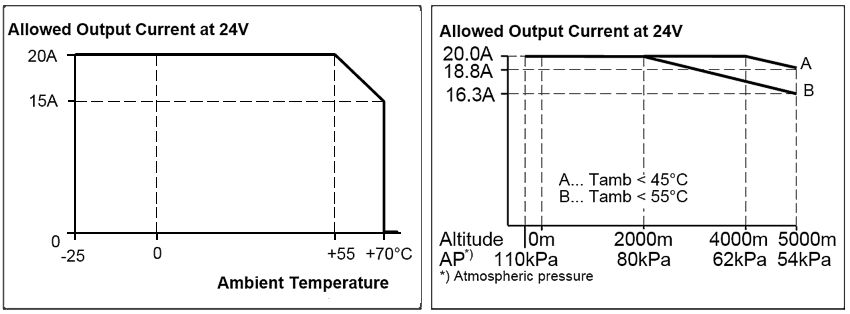Environment
Environment | ||
|---|---|---|
Operating temperature1) | -25 °C to + 70 °C | Reduction of the output power according to Fig. Output current over ambient temperature |
Storage temperature | -40 °C to + 85 °C | For storage and transport |
Output load reduction | 8 W/°C | +55 °C to +70 °C |
30 W/1000 m or 5 °C/1000 m | Installation altitude > 2000 m, see fig. Output current over installation altitude | |
The output load reduction is not hardware-controlled. Take this into account in order to stay below the nominal current limits so that the device is not overloaded. | ||
Humidity2) | 5 % to 95 % r.h. | According to IEC 60068-2-30 |
Atmospheric pressure | 110 kPa - 54 kPa | see fig. Output current over installation altitude |
Installation altitude | Up to 5000 m | |
Vibrations, sinusoidal3) | 2-17.8 Hz: ±1.6 mm; | According to IEC 60068-2-6 |
Impacts3) | 30 g 6 ms, 20 g 11 ms | According to IEC 60068-2-27 |
Overvoltage category | II | According to IEC 60664-1 for altitudes up to 5000 m |
Impulse voltages | 4 kV (according to overvoltage category III) | Input to PE |
Degree of pollution | 2 | According to IEC 60664-1, non-conductive |
Acoustic noise | The power supply unit can produce audible noise when idling, overloaded or short circuited. | |
1) The working temperature is identical to the room temperature or the ambient temperature and is defined as the air temperature 2 cm below the device.
2) Do not energize when condensation is present!
3) Tested in conjunction with DIN rails according to EN 60715 with a height of 15 mm and a thickness of 1.3 mm and standard installation position.
 Fig.10: Output current over ambient temperature; output current over installation altitude
Fig.10: Output current over ambient temperature; output current over installation altitude